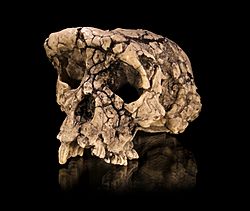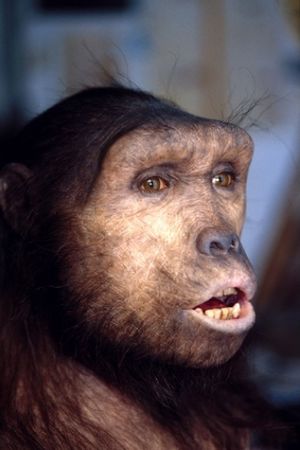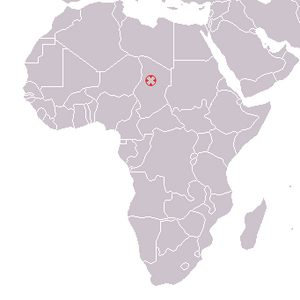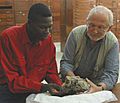Sahelanthropus facts for kids
Quick facts for kids SahelanthropusTemporal range: late Miocene
|
|
|---|---|
 |
|
| Scientific classification | |
| Kingdom: | |
| Phylum: | |
| Class: | |
| Order: | |
| Family: | |
| Subfamily: | |
| Tribe: | |
| Genus: |
Sahelanthropus
Brunet et al., 2002
|
| Binomial name | |
| †Sahelanthropus tchadensis Brunet et al., 2002
|
|
Sahelanthropus tchadensis is a very old fossil of a hominid. Hominids are a group that includes humans and our closest extinct relatives. Scientists think it lived about 7 million years ago. Its remains were found in Chad, a country in Africa.
Scientists believe that the split between the human family tree and the chimpanzee family tree happened between 6.3 and 5.4 million years ago. This idea comes from studying genes. Since Sahelanthropus is older than this split, its exact place in our family tree is still being debated. The first fossil found was nicknamed Toumaï.
Contents
What Fossils Were Found?
Scientists found parts of a skull, five pieces of jaw, and some teeth. These pieces form a head that has features like both modern humans and older, more primitive human relatives. The part of the skull that held the brain is quite small. It is about 340 to 360 cubic centimeters (cm³). This is similar in size to a chimpanzee's braincase. For comparison, a modern human brain is much larger, around 1350 cm³.
The teeth and face structure of Sahelanthropus are very different from modern humans. The skull found was damaged and squashed, so scientists have not been able to make a perfect 3D computer model of it. No other bones from the body were found. Because of this, we don't know for sure if Sahelanthropus tchadensis walked on two legs (was bipedal). However, the way the hole for the spinal cord (called the foramen magnum) is placed suggests it might have walked upright.
How Is Sahelanthropus Related to Humans?
Scientists are still discussing if Sahelanthropus is an ancestor of both humans and chimpanzees. It's tricky because its features are a mix of old (primitive) and new (derived) traits. It probably lived in areas with open woodlands and savannahs. This is different from the dense rainforests where today's apes live.
Another idea is that Toumaï is related to both humans and chimpanzees but is not a direct ancestor of either. Some scientists, like Brigitte Senut and Martin Pickford, think that Sahelanthropus tchadensis might be an early female gorilla. Even if this is true, the discovery is still very important. This is because very few ancestors of chimpanzees or gorillas have been found in Africa. So, if Sahelanthropus is an ancestor of chimpanzees or gorillas, it would be the first known member of their family line.
The discovery of Sahelanthropus tchadensis also suggests something important. It shows that the last common ancestor of humans and chimpanzees probably did not look much like chimpanzees. Some scientists used to think it did.
The other fauna (animals) found at the site suggest that the fossils are more than 6 million years old. This is because these animal species were likely extinct by that time.
When Did Humans and Apes Split?
Some studies suggest that the split between the line leading to modern apes and the line leading to modern humans happened much earlier than first thought. Scientists use mitochondrial DNA to estimate these dates.
One study looked at the DNA of a baboon. By comparing it to other mammals, they suggested that the split between Old World monkeys and apes happened over 50 million years ago. This would mean that all ape family splits happened much earlier too. For example, the split between chimpanzees and humans might have happened 10 to 13 million years ago. The split between gorillas and the chimpanzee/human line might have been around 17 million years ago. These different ideas show how complex the study of human evolution is.
Related pages
Images for kids
See also
 In Spanish: Sahelanthropus tchadensis para niños
In Spanish: Sahelanthropus tchadensis para niños





